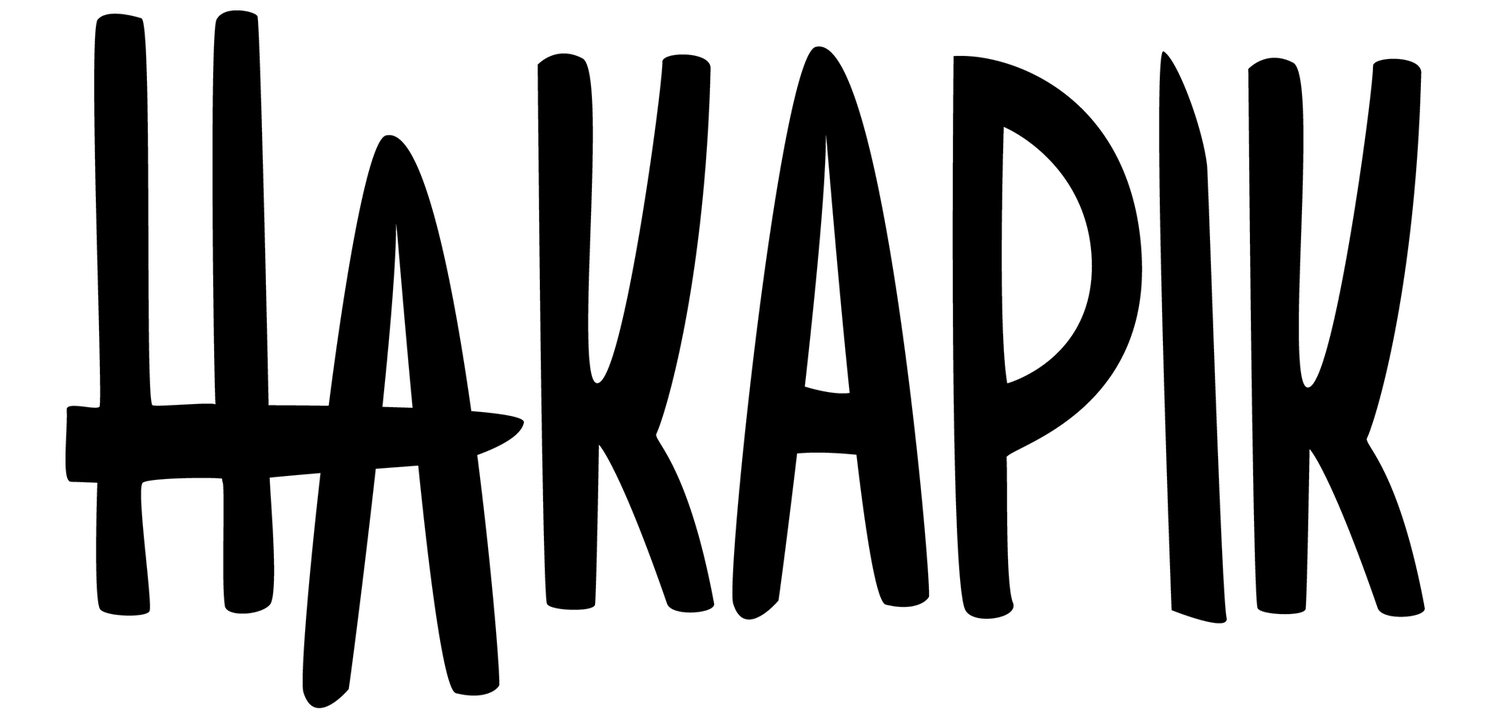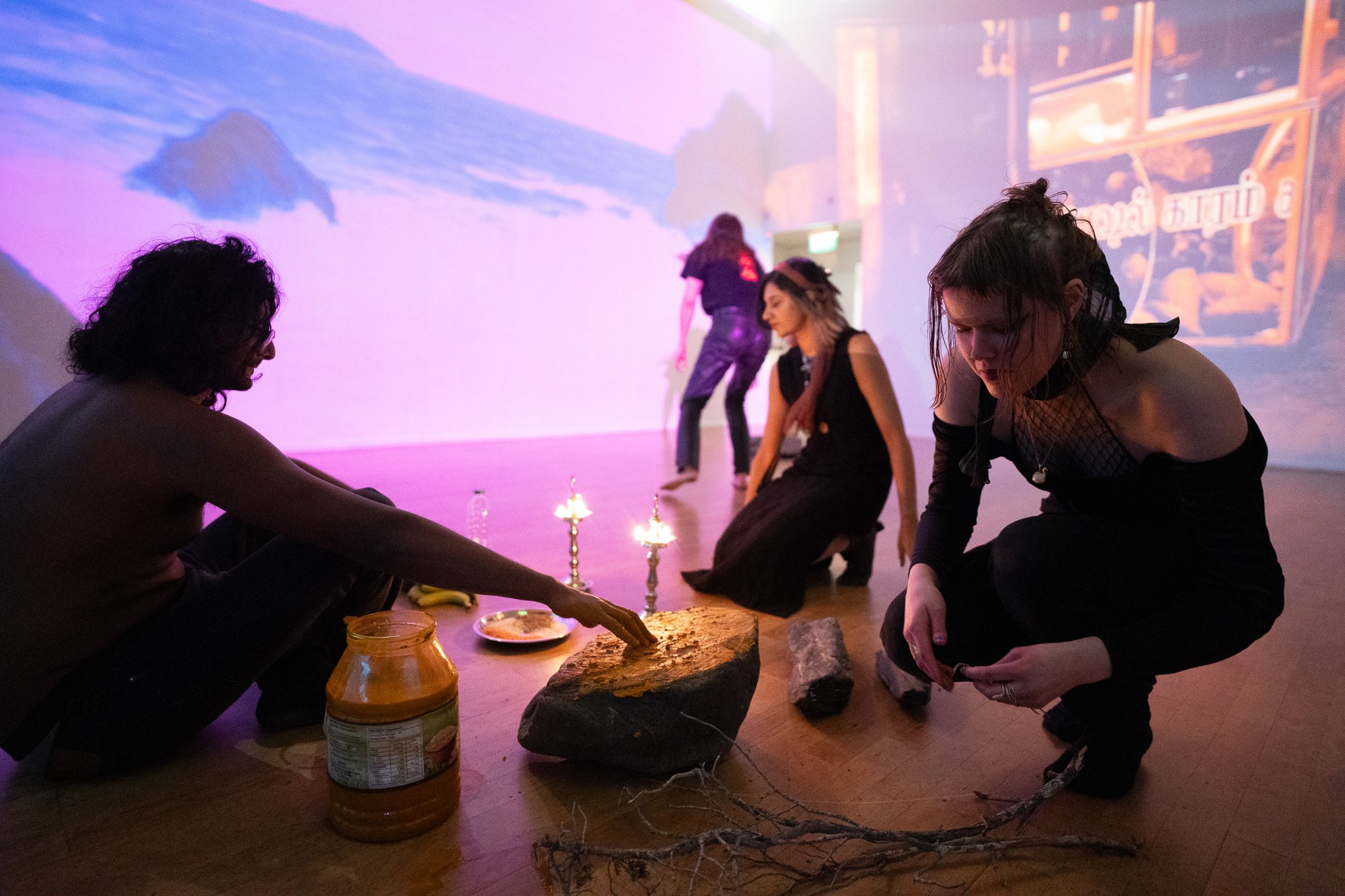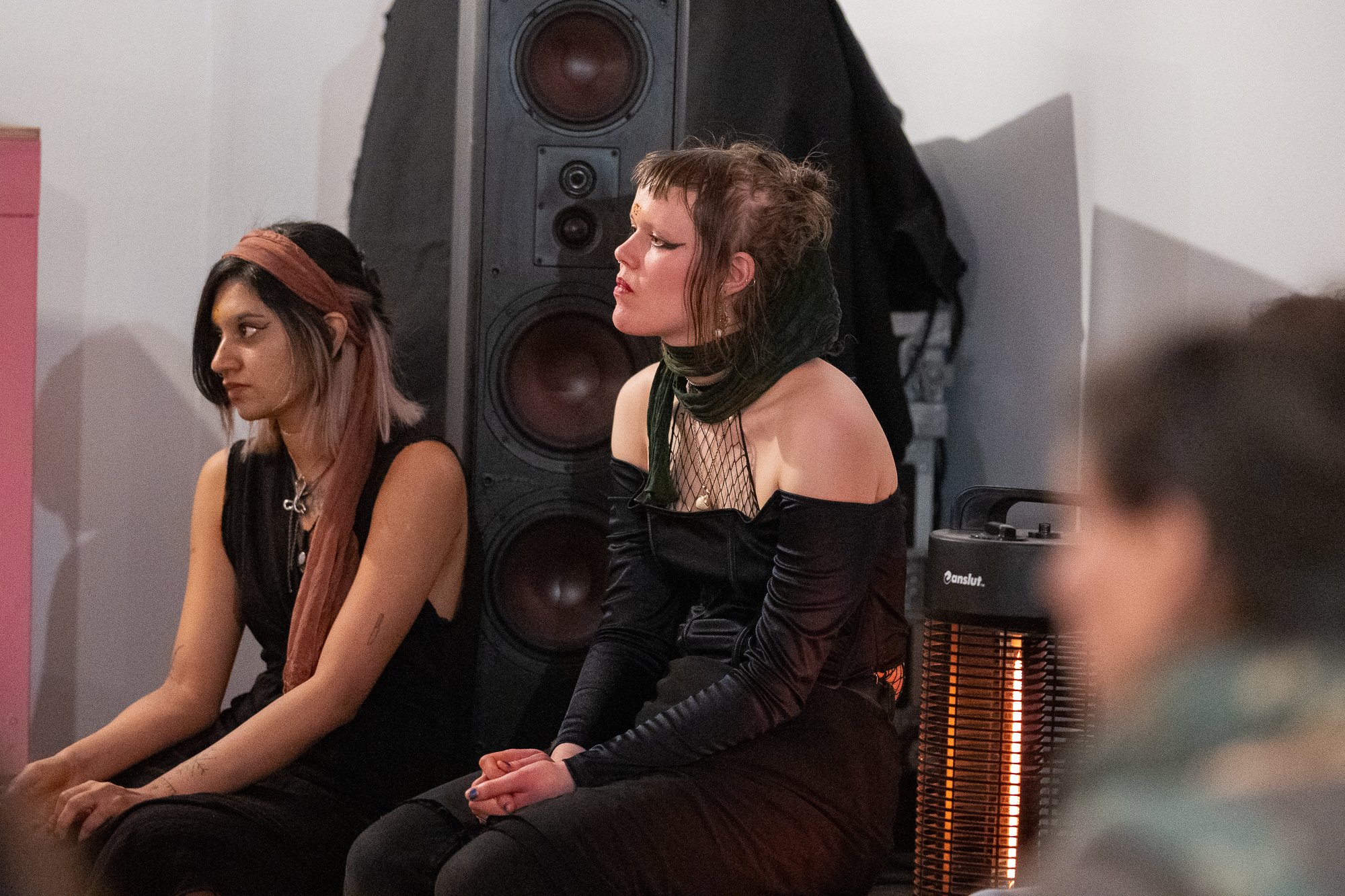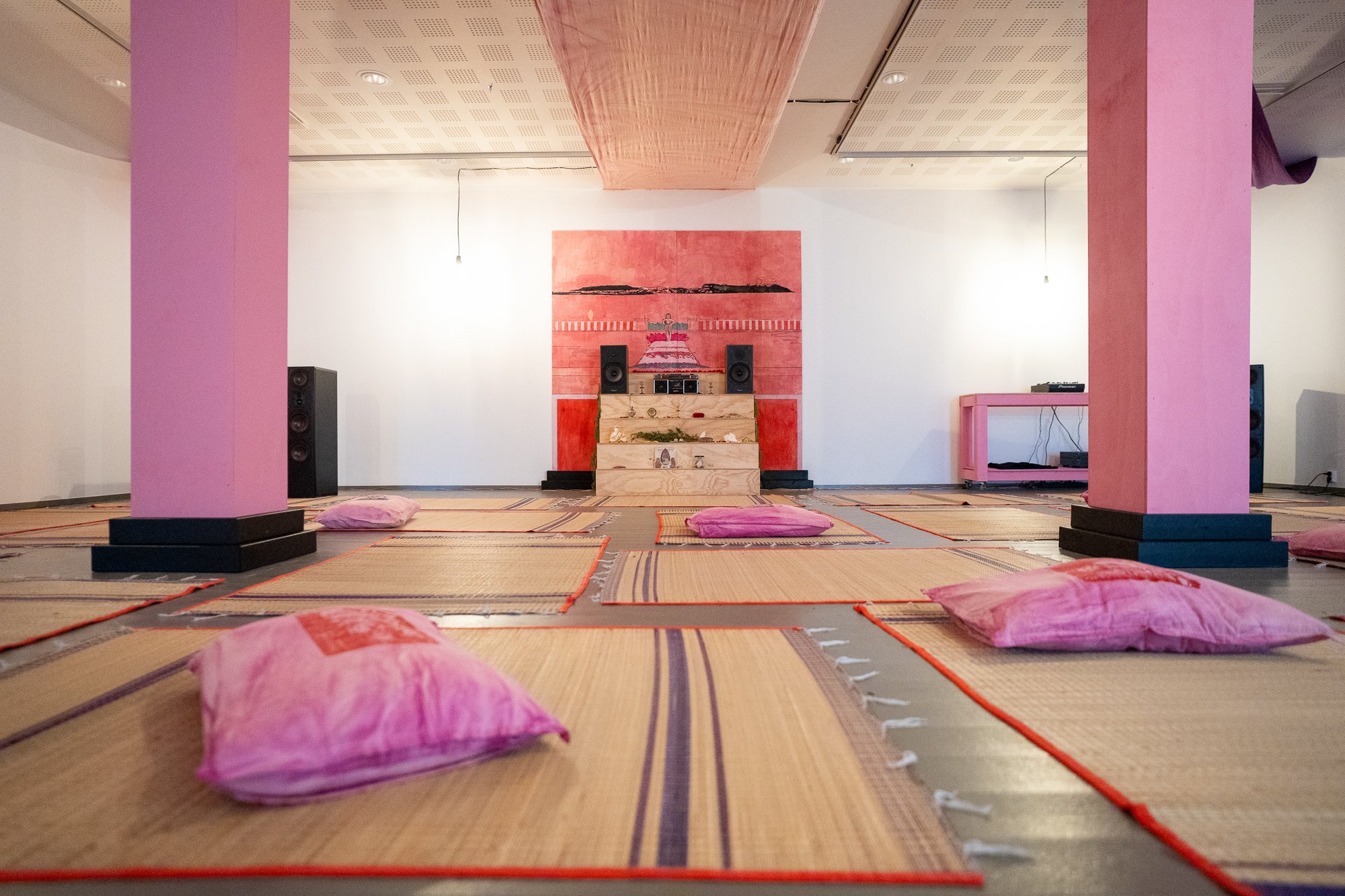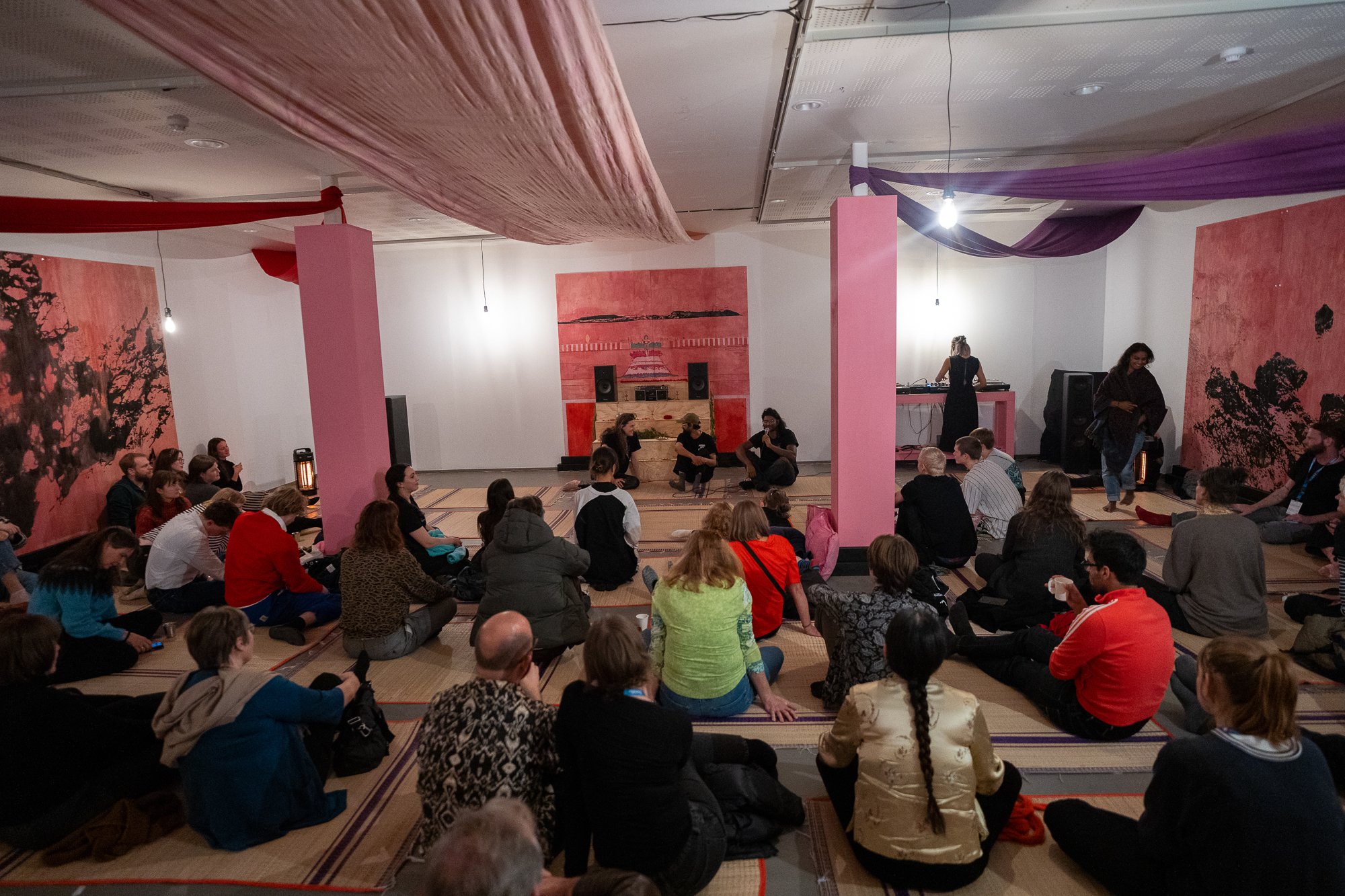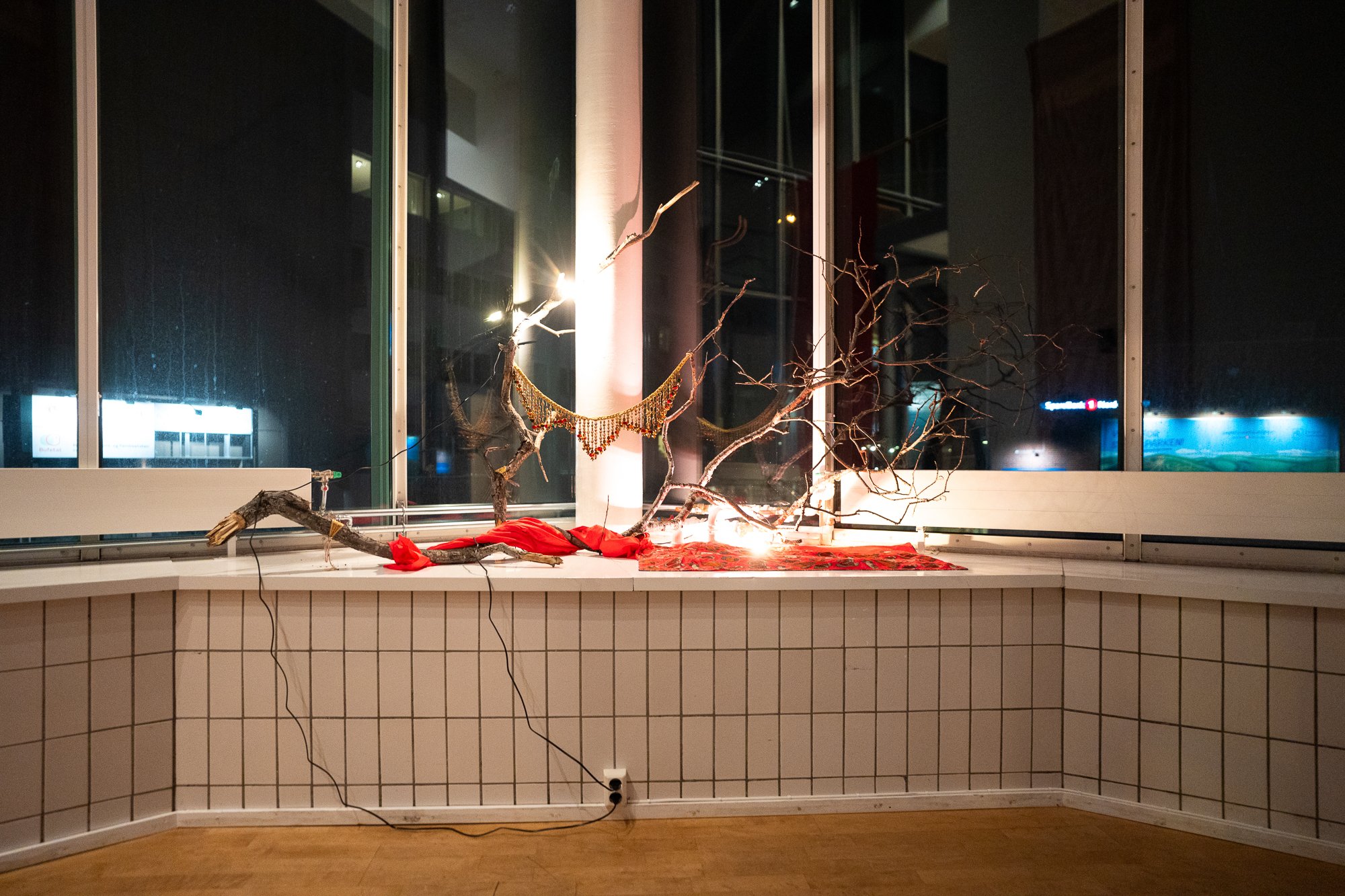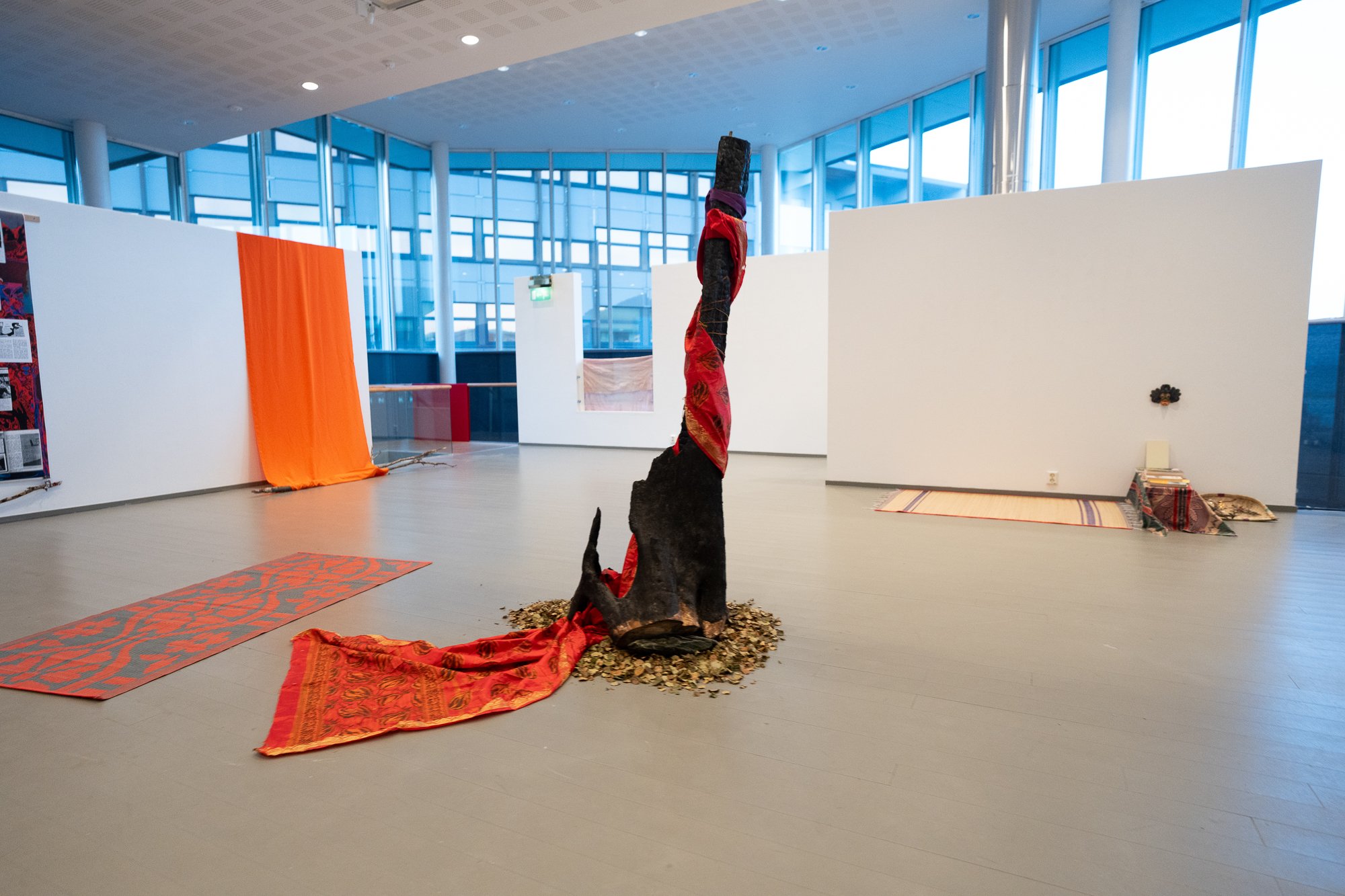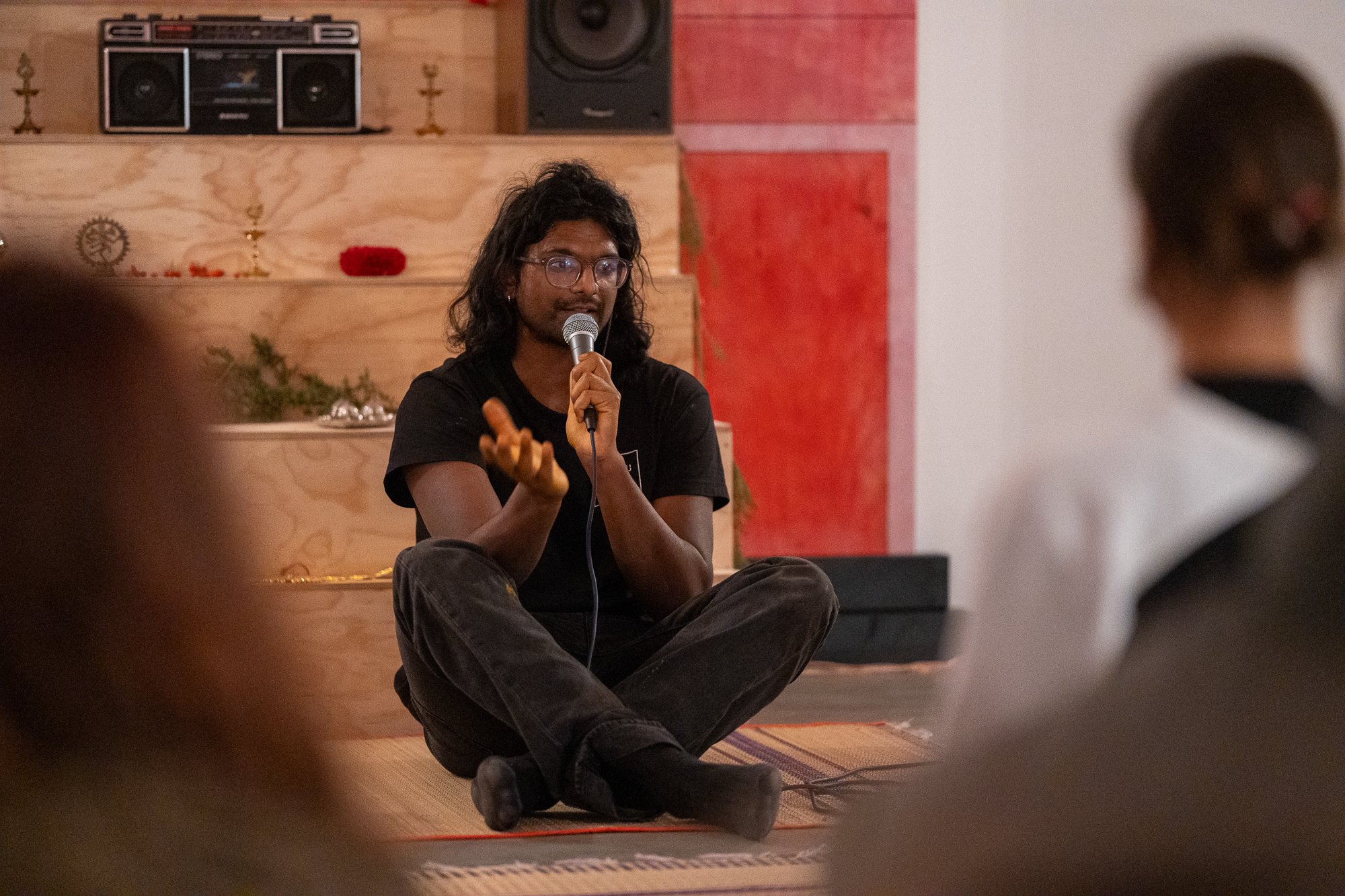Sasusu radio: A moving temple for art and healing
Interview with SASUSU Radio (Sanjey Sureshkumar, Ellen Vikström, Jette Graaner, Henrik Sørlid and Mimii), 2023.
With Verdens Ende – literally meaning “end of the world” — artist Sanjey Sureshkumar and his artist comrades dive into Tamil diaspora identity, from both a personal angle and a historical and archival perspective. In doing so, they propose a fascinating collective journey at the crossroads between documentary work and utopia.
By Marion Bouvier
More than an exhibition, Verdens Ende is a space for happenings and gathering, from radio shows to film screenings and food making. The first rendition of that space took place at Kurant9000 from March 13th to April 14th this year, and the second iteration unfolded in October at the Arctic Moving Image & Film Festival (AMIFF) in Harstad. By Sanjey Sureshkumar’s own admission, the whole project is also the continuation and a research platform to a film that has been in the making for several years, entitled Lille Eelam på verdens ende. The title refers to Vardø, a town of around 1900 inhabitants, around 10% of which were Tamil in the late 80s and 90s. “Eelam'' refers to the ancient Tamil name for Sri Lanka. Being somewhat at the geographical end of the world, but also representing a far-away land where Tamil refugees “ended up”, the nickname for Vardø stuck.
When I ask to interview Sureshkumar, the initiator of the project, he immediately requests that all the other members of the project should join as well. That is because the co-creative aspect of Verdens Ende, as it becomes clear over the course of the interview, is at the heart of the whole endeavour. And so during the interview, Sureshkumar is surrounded by Ellen Vikström, an artist and filmmaker based in Tromsø who was part of running Kurant for the past couple of years; Mimii, who is currently a MA student at Tromsø Art Academy; Henrik Sørlid, an artist and writer; and Jette Graaner, a product and graphic designer who is also Sureshkumar’s partner.
A band of artists come together
They all seem slightly nervous and excited, and in spite — or thanks — to their diverse backgrounds and motivations, there is a definite sense of mutual respect and love towards the project. Witnessing this sense of community around a topic that one could argue concerns Sanjey Sureshkumar the most — his parents being Tamil and having had to flee Sri Lanka before he was born —, I start the conversation by asking how each of the artists ended up on board the Verdens Ende ship. Ellen Vikström was the first collaborator to join Sureshkumar, and she recalls how the collaboration between the two of them evolved very naturally, as they used to study film together at the Nordland School of Arts and Film in Kabelvåg (Lofoten).
– We were in the same class and then we were organizing stuff in Kabelvåg, like parties in your basement, trying to make things happen in different ways. And then you (Sanjey) started this project with your father to build a sound system in your car. And I was filming and documenting and being part of the whole thing — not in strict terms, but both of us taking on more fluid roles, where the process was also discussing lots of topics, discussing intimate and personal stuff as well as political things, for example how to create platforms for what we want to do.
The “Tiger Milk sound system” project started in 2018 and would become one of Sureshkumar’s long-running projects, whose fluidity and collaborative nature illustrates the artist’s way of working. With the car and its powerful integrated speakers came the name “SASUSU Radio”, a Norwegian-Tamil radio platform that has been more of a moving platform for conversations than a radio per se. The car is also the project through which Jette Graaner first got involved in Sureshkumar’s work, as she built the wooden structure designed to host the speakers in the back of the car.
– I really enjoy making practical solutions to embrace what we’re trying to communicate and make inviting spaces for our exhibitions, she comments.
Henrik Sørlid joined this loose group of friends and artists in 2022. He describes his “recruitment” as quite an organic process, involving late night talks about politics and finding common ground in many of their political and artistic interests. Then last year, Sureshkumar asked Sørlid to co-curate Verdens Ende at Kurant, and the latter initially hesitated in saying yes, although undeniably enthusiastic towards the project:
– When Sanjey asked me to be part of making the exhibition, I was super flattered, it was really an honour to be asked. But also, I felt maybe I’m not qualified, I felt I didn’t know enough about the Tamils, about Sri Lanka. But Sanjey was like, ‘Oh come on, you know what this is about.’ He had to convince me and help me see what I could contribute with.
Sørlid continues explaining why the project appealed to him:
– I felt that this process of opening up a space for conversations was important; and I think the issues related to migration are of concern for everybody, even though in this case the starting point is specifically from the Norwegian-Tamil perspective. Some experiences are owned by specific communities, but the socio-political questions around these experiences are common to everybody.
The last member of the patchwork of artists making up Verdens Ende is Mimii, an art student who laughingly tells the story of being asked by Sureshkumar to join the exhibition “in a bar, late at night.” She says that with her father being Tamil, she had always wanted to explore her cultural heritage more in depth, and was connecting with him through the project. She describes the experience as “eye-opening.” One of her main tasks during the month of events was making Tamil tea. That straightforward task is, however, of important significance to the cosmology of Verdens Ende. Indeed, when trying to identify what the group of artists tried to build within the exhibition space, it appears that rituals are one of the foundations of creating community and presence.
A new temple is born
Rituals represent the anchor that people can take part in, and also a point of access for the non-Tamil audience to enter the Tamil world that Verdens Ende brings forth.
– A big part of what we did was discussing rituals, to show people another mode of being when they enter the space. We focused on thinking about the practical use of the space, the small things: for example, the shelves to take off your shoes at the entrance, the tea that you get offered, sitting on the floor closely with other people, and being warm. We also focused on creating different spaces for different rituals.
Henrik Sørlid adds that it is these “sensory-based impressions” that give the audience cues on how to put your body in this particular space, clearly communicating that this is a Tamil space, and being warm and inviting.
Further, the creation of rituals points to another aspect of Verdens Ende’s concept: to make the gallery space into a new kind of temple. Sanjey Sureshkumar explains thinking of the project as a meeting place, and that the connection with the temple naturally came up.
– We were inspired by Eelam Tamil temples from northeast Sri Lanka. The temple is a meeting place where people meet and heal together, and that they also use for worship. Of course, it is framed by Hindu mythologies in Sri Lanka, but we are here (in Norway), so we can frame it in other ways. That is interesting to me: what happens if we include all our perspectives into this, and feed it back to this space?
That in turn refers to the premise of co-creation: a temple is a building, but it is also a sociological space that is created by those who enter it, by the kind of communion that takes place in it. That shapeshifting quality of the temple applies well to Verdens Ende’s purpose of creating a space that reflects the plurality of voices that compose it. Sureshkumar emphasizes that a lot of the inspiration behind the exhibition comes from his memories and interpretation of Tamil culture, but that it does not represent a fixed reality of what being Tamil in Norway is or means in general.
– That’s the whole point, we want to give something for the future, and also just for us to have a space where we can work creatively together, Sureshkumar comments.
As he recalls people calling this project and other politically relevant artworks “important”, he reflects:
– Of course, we created this out of some kind of necessity. But we’re keeping the fluidity and the interest and the joy in making things as well. It becomes something else than just important.
Sureshkumar also shares the strange mix of joy and frustration of working in this particular collective way:
– We do everything together, we paint the walls, we set things up, and then suddenly we find other solutions, or someone comes in and bounces off the idea someone else had, and it becomes something totally different. That can also be very frustrating. But at the same time, that’s the whole point, you always have to give up something, right? It brings us back to the fact that I’m not in Sri Lanka anymore — I was not even born in Sri Lanka. You just have to accept that there are some things you lose, that you don’t get to bring forward. And something else comes up.”
Verdens Ende in Harstad
The conversation turns to recreating Verdens Ende away from the intimate, small space that is Kurant and into Galleri Nord Norge, a former swimming pool of vaster proportions and colder architecture. “How did the artists approach this new type of space?” I ask. Henrik Sørlid offers a tentative answer:
– To be honest, we were maybe a bit sceptical at the beginning. Or apprehensive, and we spent a lot of time and effort looking for alternatives, we felt that maybe the space is too big, too institutionalised. At the same time, we thought, ‘maybe that’s the kick in the ass we need to go to the next level.’ We talked about how it’s essential that the space serves the project, and not the contrary.
Jette Graaner chips in and describes finding her peace with that choice and being very positive about it.
– I think the most important part is not filling up the space but getting in the atmosphere and doing all these rituals to be present.
It was Kjetil Berge, curator at AMIFF, who asked for Verdens Ende to be part of the moving-image festival’s program. It started in 2022, when Berge was curating an exhibition in Oslo that he entitled “Bend It”, which was in some ways a celebration of queer history in Norway. The curator asked Sanjey Sureshkumar to join in with his SASUSU Radio project. The artist was hesitant, feeling that it wouldn’t really fit in. But Berge insisted and Sureshkumar relented, on his own terms. He gathered seven or eight of his artist friends and gave a “hell of a performance” involving his car’s massive sound system, and then left the space without further explanation. Kjetil Berge loved it and asked for SASUSU Radio to be part of AMIFF, and this time, a closer understanding united the two projects.
– It’s about building coalitions across the spectrum, across different struggles in different communities. We want to challenge ourselves, and challenge people, and engage with things on the background of solidarity across whichever dividing lines you can see. In that sense the concept of ‘queer’ Kjetil works with is something that resonates with how SASUSU Radio is already operating.
Reaching across the divide over a cup of tea
Remembering the warm and welcoming atmosphere that I experienced when visiting the Verdens Ende exhibition at Kurant in March, I wonder what the artists themselves felt about the 5 weeks experience, and if anything in particular surprised them, positively or negatively. Mimii recounts being happily surprised to observe that the audience, especially the non-Tamil, reacted so positively to the project, that they were engaged and had such an open mind to the topic. Jette Graaner echoes this feeling, adding that the audience was very gentle, really holding space for the radio show guests who were talking about very personal and difficult things. Henrik Sørlid, too, felt both humbled and encouraged by the feedback from the audience, both the non-Tamil showing interest in Tamil history and culture, and the Tamil people who found the experience meaningful.
For Ellen Vikström, there’s a precise memory that comes through:
– I’m just thinking of how wonderful it was to watch a three and a half hour Tamil devotional movie without subtitles! Even though you don’t understand everything, it’s so expressive. I was impressed with how many people stayed and watched through all these hours.
Sanjey Sureshkumar talks about the many memories he’s accumulated over time, and then a particular memory shines through. It was that time Kalyany Sivagnanam — a Tamil music and dance teacher — was a guest on the radio show. Before she went on air, she had to listen to an hour-long conversation Sureshkumar and Sørlid hosted with Øyvind Fuglerud, an academic who has worked on the Norwegian peace process in Sri Lanka and who has criticised the Liberation Tigers of Tamil Eelam organization (LTTE). Since the conversation was pre-recorded, Sivagnanam couldn’t intervene or respond, and at the break, she expressed to Sureshkumar in Tamil how angry listening to Fuglerud had made her: “How can he talk like this about us?” she asked. Sureshkumar replied that they were trying to offer different perspectives on the topic, and that her turn to talk was coming up and she could express her point of view. As the radio show resumed, Sivagnanam immediately started talking about that time she and other Tamils were demonstrating in Oslo at the end of the last genocide committed against Tamils and told her story. Sureshkumar recalls:
– I felt there were lots of feelings coming through, not only because of Øyvind’s talk, but also because she hadn’t had that audience before. All these people who wanted to listen to her story and take it seriously. So, at the end, she was so happy. She said it was amazing. That was really great because then suddenly maybe the temple had something to do with that, coming into the temple facing hardships, and maybe finding a space to heal.




